English Mastiff Dog Breed Information: Facts, Traits, Pictures & More
When you purchase through links on our site, we may earn a commission. Here’s how it works.
The Mastiff, who is sometimes commonly referred to as the English Mastiff or the Old English Mastiff, is one giant dog. He is handsome, he is sweet, he is gentle, and boy, is he big! His size alone means that he is not suitable for many family homes. So, you’ve really got to size him up before you commit to taking him on.
Table of Contents
Those who are experienced with the breed can attest to the fact that their size isn’t the only thing that you’ll need to manage as an owner. They are quite stubborn and can be territorial. This can be a problem with a giant breed. How do you handle it when it’s snowing outside and your 200-pound dog refuses to come inside? These are questions you’ll want to answer before welcoming one into your home.
From the Mastiff’s size to their living requirements, training needs, and how much food they eat, you’ll need to become an expert on each before welcoming one into your home. These big, lovable dogs can be the best family dogs on the planet as long as they are properly trained. Let’s take a look at what you can expect when you adopt an English Mastiff.
History
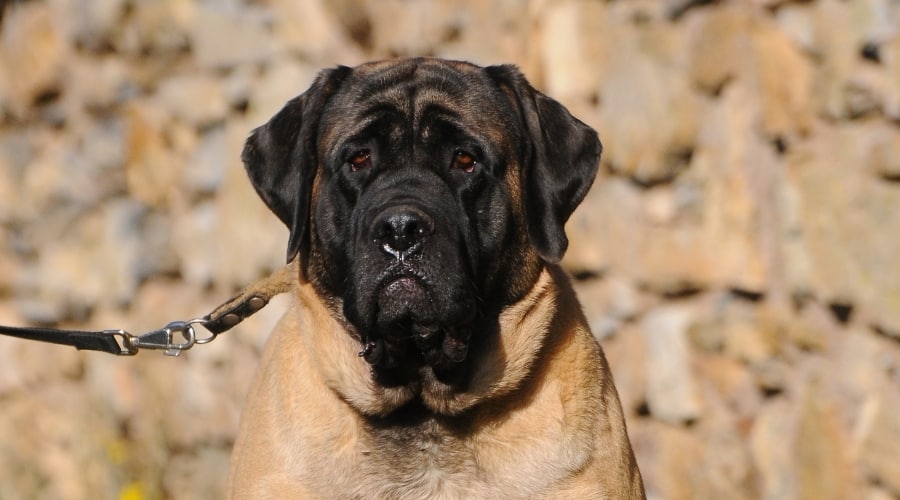
The English Mastiff is from, you guessed it, from England. He is an ancient dog breed that originates from 55 B.C. We know this because Julius Caesar, the great Roman conqueror, made a note in his journal about them. When he invaded Great Britain, he was in awe of the breed and their sheer power. He took them back with him to Rome, where he fought them in the ring against lions, other beasts, and human gladiators.
Medieval England is when he came into focus. Rich landowners continued to use him as an estate guard, and they also used him for hunting large game. He was also the war dog of choice in the 15th-century battle between the English and the French. But they were expensive to feed, so only the richest people were lucky enough to have them.
Fast forward to the 19th century, and the Mastiff breed was nearly fought to death because of the cruel dogfighting bloodsport in England. The breed managed to recover their numbers. But come the 20th century, the breed almost became extinct, and just 14 of them were left. Thankfully, the English Mastiff was also popular in America. American breeders exported their fine specimens to their native land and restored the breed. Phew!
He was much bigger back in the day, and over time, he has become much smaller and less ferocious. It’s difficult to imagine just how big he really was! He is no longer used in battle, but instead, he can now be found soaking up the sun in the yard or snuggling on the sofa with his favorite humans. He is consistently found in the top 30 dog breeds, according to the American Kennel Club. And if it wasn’t for his humongous size, we think he’d be much more popular.
Temperament
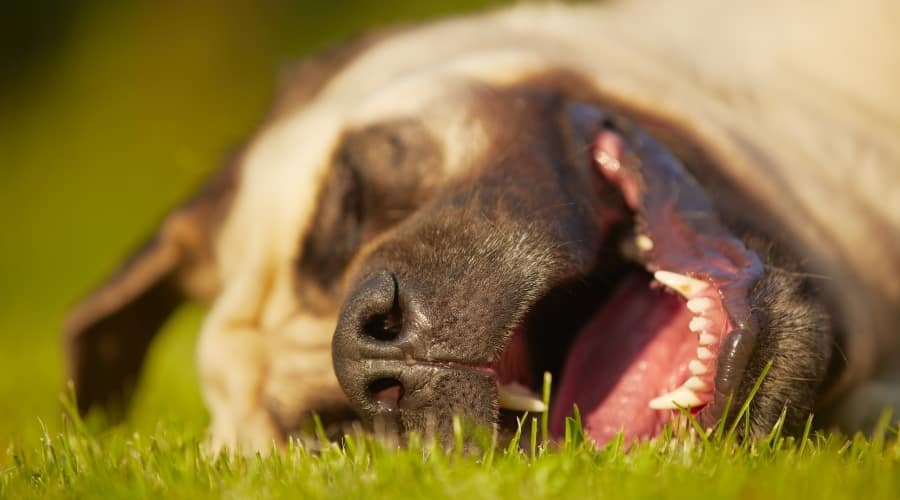
The English Mastiff is a chilled-out canine. He is so laid back that many people assume that he doesn’t have a care in the world. And they’re probably right! This breed is happy to snooze with you all day long, and he’d skip exercise if you’d let him. This breed snores a lot. Louder than most humans, in fact.
Mastiffs love to be silly with their families. Just watch out because his uncoordinated body and thick tail will send things flying in all the excitement. Especially during puppyhood because he is a super clumsy teenager. It takes a few years for them to understand how to use their bodies.
Thankfully, he saves fun for the outside, and he is calm in the home. This delightful doggy is a true gentle giant and is surprisingly quite sensitive. He doesn’t like family arguments and is quick to comfort his loved ones if they are having a bad day.
But when it comes to intruders or those threatening his family, he will be quick to protect them. He is aloof with strangers but polite enough to let his master do the talking. Regular visitors will get special treatment. This courageous canine is super loyal, and he will forge a strong connection with the children in the family as they need his protection more than anyone.
Don’t allow him to get too protective, though, because he needs to know that he is not the boss of the home. He is a headstrong dog who needs fair but firm guidance. With a Mastiff around, you’ll quickly come to realize how stubborn they are. If you are seeking a fully obedient pup, it’s time to skip to the next breed.
Size & Appearance
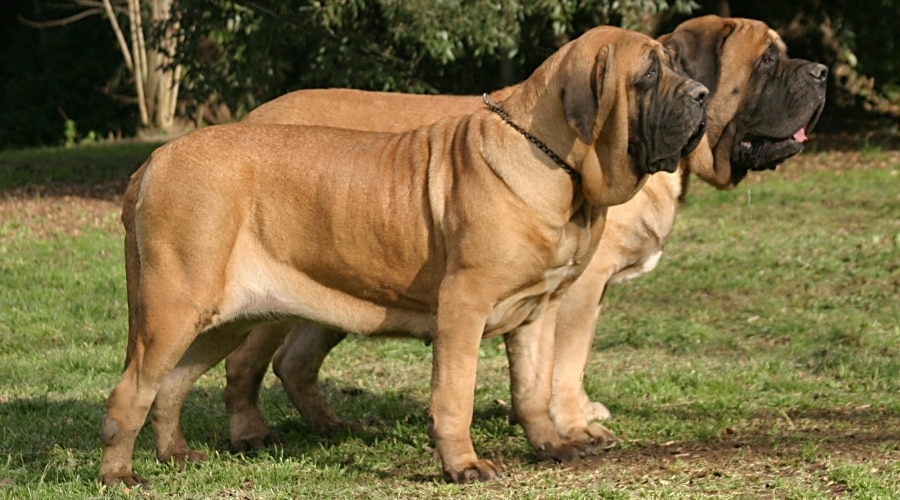
Make no mistake, this is a giant dog breed, which is any breed that weighs more than 100 pounds at maturity. Typically, he weighs between 120 and 230 pounds. See our English Mastiff growth chart. Females measure a minimum of 27 ½ inches, and males measure a minimum of 30 inches. This makes him the largest dog breed. A Mastiff named Zorba was the heaviest dog to walk this planet, and he weighed in at a whopping 343 pounds. Although your dog will probably not reach this weight, he could. So bear that in mind!
This giant dog is thick and chunky. In his breed standard, he is described as looking massive in appearance when viewed from any angle. He is muscular, powerful, and strong enough to pull heavily laden carts. He also has a fair bit of body fat, and he is often rolly. His slow metabolism and love of napping mean many Mastiffs, unfortunately, find themselves overweight. He has a thick barrel chest and sturdy neck to carry that big head of his.
He has a long tail that packs a punch when it swings from side to side. The breed has long drop-down V-shaped ears that graze his droopy jawline. His medium-sized dark eyes are always alert and kind in appearance, and his droopy jowls give him a sweet look. The jowls and often rolly and wrinkled face also give him a quizzical look, completed by his eyebrow wrinkles.
Coat & Colors
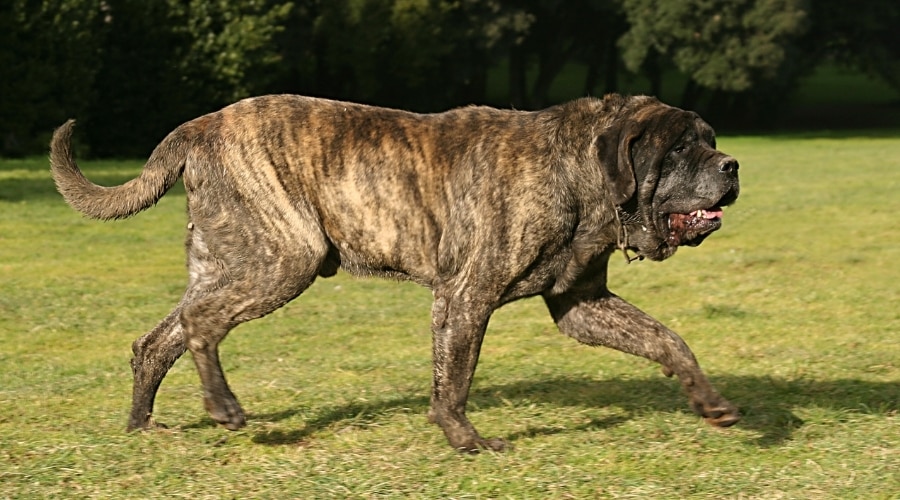
Most mastiffs have a short double coat. His outer coat is moderately short in length and straight and coarse in texture. His underlayer is dense, short, and sits close to his body. Together the layers keep him warm in the winter and protect him from the elements in the summer. Fluffy or longhaired Mastiffs are much rarer than the rare short coat. These fluffy pups are not allowed in the show ring, but it has no effect on their personality or how lovely they are!
There are three coat color options that are considered breed standard. Apricot, fawn, and brindle. Brindle coats should have an apricot or fawn base color, completely covered in dark stripes. His muzzle, nose, and ears should be dark in color – the blacker, the better according to his breed standard. Some Mastiffs will have a small white patch on their chest.
Exercise Requirements
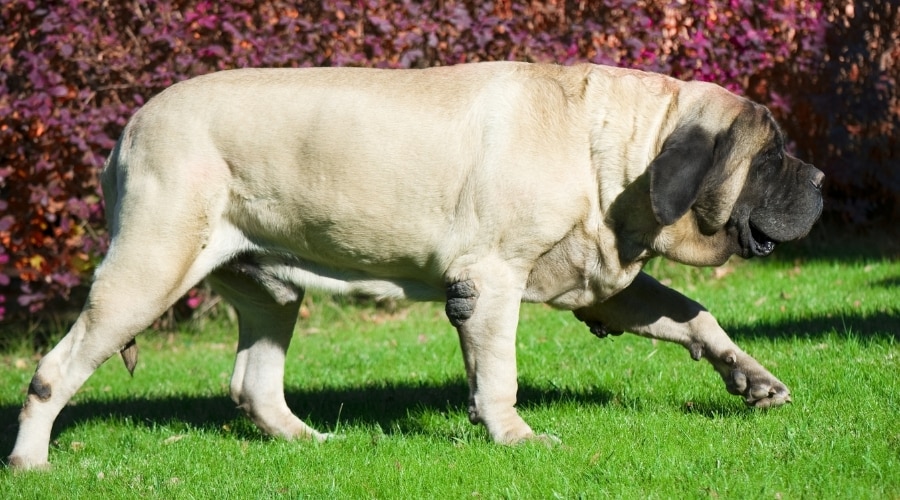
The Mastiff needs around 45 minutes of exercise every day, no matter how much he tries to persuade you otherwise. And he will try to convince you that he doesn’t need that much, or any, some days. To keep him fit and healthy and get that big ticker of his working, you need to ensure he is exercised daily. Teaching him the words ‘doggy park’ is bound to get him excited.
With that being said, he does need to be entertained during the day. You cannot expect him to nap all day long without any stimulation. Because, like all dogs, he will get bored. And bored dogs are destructive. Interactive playtime in between, or chew toys, is a great way to keep him amused and stimulated. You’re going to need some seriously large toys for this pup.
This lazy pup isn’t going to be up for hours of mountain hiking. In fact, too much at once or exercise that is too impactful will be more damaging to his large body than it is healthy. If you are a seriously fit family looking for an exercise partner, this is not the breed for you. Instead, if you are a moderately active family looking for a canine to keep you company on leisurely strolls, he is perfect.
Living Conditions
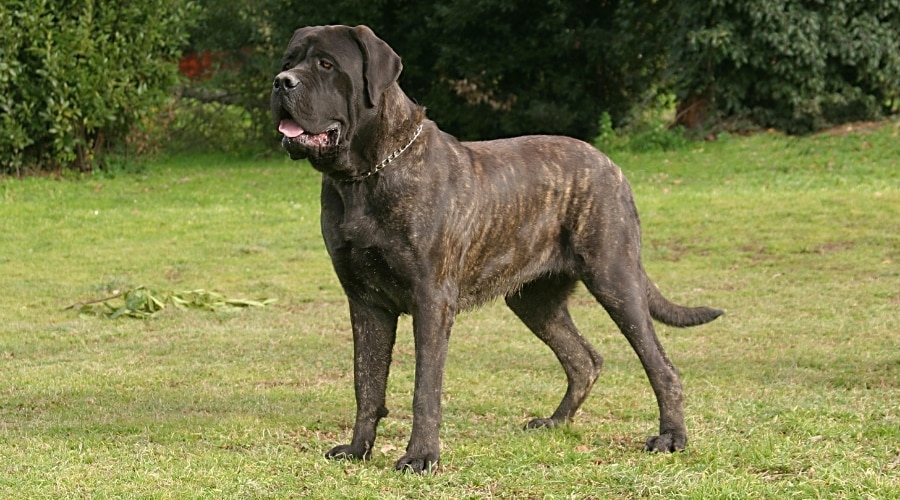
Believe it or not, English Mastiffs can live in an apartment. While it’s preferred to have a large home with plenty of space, they can survive just fine in an apartment due to their lower energy levels and low exercise needs. They should not, however, live in anything but a first-floor apartment. Also, homes with stairs will need to have extensive training so your pup doesn’t take a nasty spill and injure themselves. As long as they are properly exercised, they will spend most of their life napping for 15 to 18 hours a day.
If he is socialized adequately as a puppy, he will coexist happily with other family pets. As we said, he loves children, but his humongous size would be better saved for older children. Infants and frail elderly individuals are not the best matches for his big booty and tail. What he does need is a family that is experienced in dog ownership because his stubborn and headstrong ways might be too much for a novice dog owner.
Training
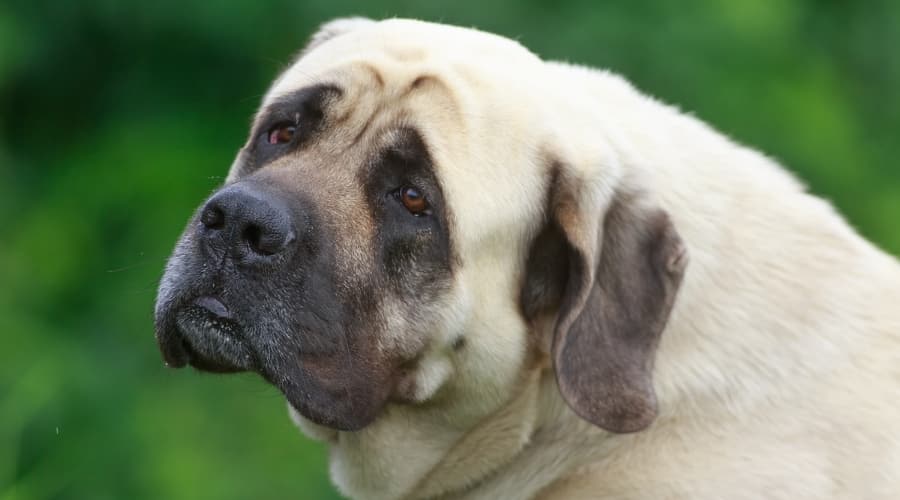
Following on from that point, his experienced owners also need to be strong and able to direct him. This breed is much happier in a family where there is an established hierarchy rather than wondering who the boss is. Firm but fair training is key, as is persistence. If you’ve let him off once, he’ll try his luck time and time again.
With early training and the right direction, he is a trainable dog. No matter how dopey and clumsy he might act, he isn’t stupid. Many owners claim that he intentionally plays dumb to get away with things other dogs wouldn’t. He isn’t the most eager to please his master, compared to a German Shepherd per se. But he can be motivated by food or treats.
The mighty Mastiff needs to be socialized from a young age. Otherwise, like all dogs, he will grow into an unpleasant handful. But at 230 potential pounds, it could be unbearable. Socialization is the process of exposing him to new and unfamiliar situations, people, dogs, and other animals. Not only will it increase his confidence as a pup, but it will teach him how to be a polite dog and ensure he doesn’t become overprotective.
Leading on from his large size, it’s also a good idea to leash train him as a pup, too. Because if he isn’t leash trained, it’ll be him taking you for a walk, not the other way around. Research how to leash train him as a pup, and get started straight away. But ultimately, no matter how well trained he is, you need to be fit and strong yourself. We also recommend crate training. Make sure your crate is big enough.
Health
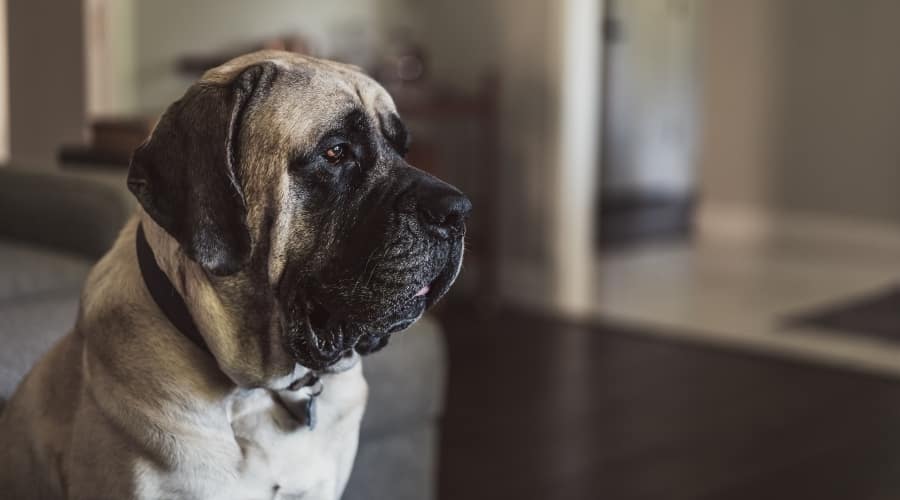
Like all giant dog breeds, they have a much shorter lifespan than most other dog breeds. The Mastiff usually lives around 6 to 10 years. The most effective way to extend their lifespan is regular low-impact exercise, high-quality nutrition, and buying from a reputable breeder. Like all purebred dogs, the Mastiff breed is affected by certain health conditions more so than others. Below are the most common.
Gastric Torsion: Gastric torsion happens when a dog eats too quickly before or after exercise. This causes the stomach to twist with food inside. This is a serious condition that impacts deep-chested dog breeds. It can be life-threatening.
Hip and elbow dysplasia: These conditions affect many large and giant dog breeds. This is because their bones are subject to rapid growth, giving them all the more chance to grow unevenly. This uneven bone growth affects the hip and elbow joints, and it can be painful and debilitating.
Eye conditions: The breed is prone to a variety of eye concerns. The most common is entropion and progressive retinal atrophy. Cataracts also affect the breed, and it is a common cause of blindness in older dogs.
Cardiac conditions: The breed’s most common concern is pulmonic stenosis. This is caused by a partial blockage between the heart and the lungs, meaning his heart has to work much harder than it should. If he faints during exercise or gets overly tired from just a little bit of activity, schedule a veterinary appointment.
CCL Tears: Bigger dogs are harder on their tendons and joints. Dogs that are bred without care for their health concerns often produce puppies prone to certain genetic health defects. CCL tears are also common with giant breeds who have been spayed or neutered too early.
Nutrition
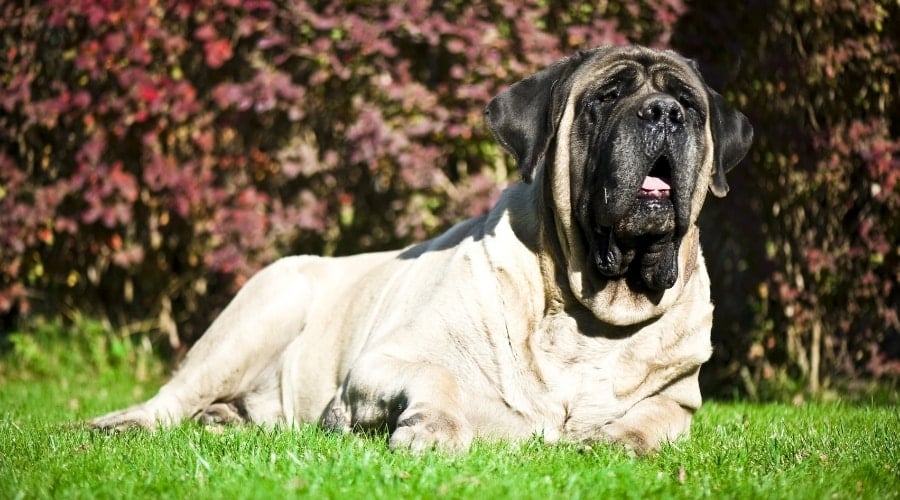
The average English Mastiff will eat around eight cups of food every day. Bearing in mind that his weight can range from 120 to 230 pounds, it is wholly dependent on his size. To avoid overfeeding him, be sure to follow the package instructions. Always feed your Mastiff a high-quality kibble and the best that your budget allows.
It’s also crucial to feed him a kibble designed specifically for large or giant breed dogs. These kibbles contain the optimum nutrients for his large body. As well as the precise calcium and phosphorus ratio that will help to control his rapid bone growth. Giant breed puppy food is a must because it can decrease his chances of developing skeletal problems such as joint dysplasia.
Mastiffs need a lot of food, but they will eat and eat and eat if you allow them to. His joints already have enough weight to contend with, so you need to keep his eating under control. Obesity is a major health risk, and if you notice that he is piling on the pounds, switch him to a weight management kibble. And get him moving too.
Grooming
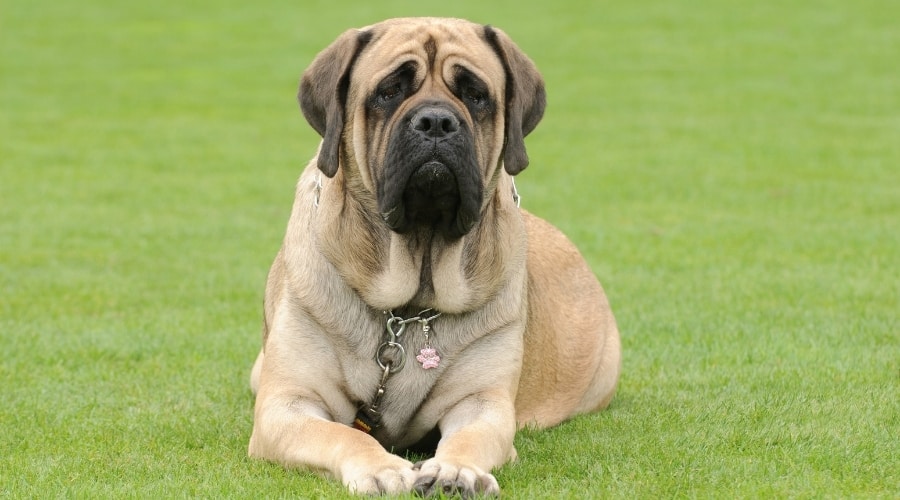
The English Mastiff has a relatively simple grooming regime. His short coat only needs brushing once every week throughout the year to keep him clean and tidy. He sheds moderately throughout the year. You should look to brush him twice a week during the shedding seasons to keep his shedding manageable.
Bathe him once every 8 to 12 weeks. Never shampoo him more than this, as you risk damaging his natural coat oils. Use a gentle formula that is made with natural ingredients to get the most effective wash. This breed is known to have a strong doggy odor, but frequent brushing and suggested bathing will minimize this.
Other grooming regimens, such as nail clipping, eye and ear cleaning, and dental brushing, are the same as any other canine. Nail clipping is as and when they need it – clipping on the floor is a good indicator that they are too long. Dental cleaning should be done once weekly. Use his grooming time to check over his body for any changes that might need veterinary attention.
Although his grooming schedule is relatively simple, there is one thing that we need to point out. If you aren’t a fan of drooly dogs, you need to abort ‘Operation Welcome-A-Mastiff’ now. Turn around and keep walking! Unfortunately, almost every mastiff is drooly. However, those needing a tighter lip line can explore the American Mastiff instead. You’ll need to keep tissue stations around the house and just come to terms with regular dribble coatings.
Breeders & Puppy Costs
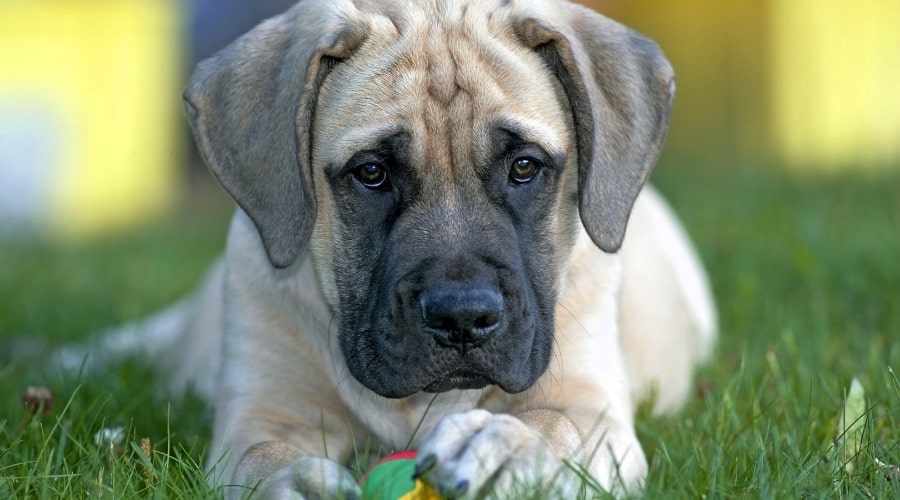
These gentle giants are popular dogs in America, and there are usually reputable breeders in every state. Your job is to sort out the good breeders from the bad and the terrible. Speak to other like-minded Mastiff lovers, and ask for breeder recommendations if they were happy with the process. Alternatively, the AKC’s list of reputable English Mastiff breeders is a great place to start your search.
Reputable breeders will want to meet you in person and make sure that you are ready and suitable for a life with a giant breed. It won’t be just you asking the questions here. Meet the puppies and their parents, as well as see their environment. Make sure it is clean, warm, and safe. Good-quality breeders will provide health certificates, as well as aftercare.
From a reputable breeder, the average price of a puppy starts at around $1,500. This is an expected price for a giant breed pup. Remember that it isn’t just the initial price that you need to consider. You also need to consider the other puppy costs, such as setting up your home for a dog. Plus ongoing food costs, medical care, giant dog beds, and we recommend dog insurance. The Mastiff is one of the most expensive dog breeds to care for, so you need to be financially committed to his needs. Before bringing your Mastiff home, use our guide to find the perfect name.
Rescues & Shelters
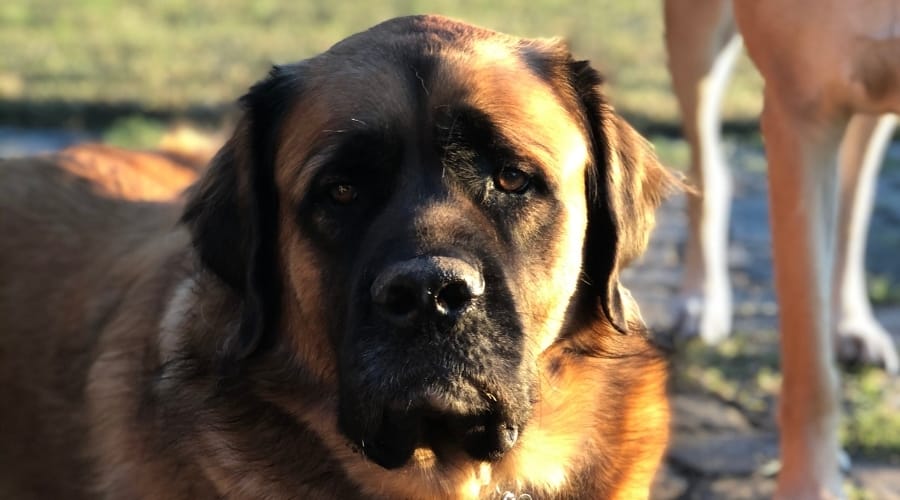
If you are considering adopting a rescue rather than buying a puppy directly from a breeder, you are in luck. Many dog owners don’t understand the commitment that comes with owning a giant breed. Because of this, many of these beautiful canines end up being surrendered to rescue shelters. There are many giant breed rescue centers you can find online that are committed to helping larger dogs.
If you aren’t having any luck at your local shelters, there are rescue shelters across the country specializing in English Mastiff rescue. The Mastiff Club of America lists several rescue centers region by region. And the Great Plains Mastiff Rescue is another great rescue website. If you are open to a mastiff mutt like a Mastador, you’ll have a much higher chance at success of adoption.
As Family Pets
- Mastiffs are courageous dogs who will guard their families with their life.
- They are generally quite suspicious of strangers.
- Most dogs will warm up to regular friends and visitors.
- Train out any territorial behavior, as this breed is known for it.
- These gentle giants enjoy their time on the couch.
- Expect a very strong dog, both physically and mentally.
- Because of their size, they need strong and experienced owners.
- He will happily coexist with other dogs and family pets if socialized properly.
- While they spend most of their days napping, they will play with toys.
- As heavy chewers, don’t expect your pup to engage in too many games of fetch.
- Leverage moderate exercise throughout the day to discourage improper behavior.
- Provided they are exercised properly, they can live in an apartment setting.
- Mastiffs can be very vocal. They love to talk and will bark at strangers.
- They are excellent family dogs and tolerate both ear and tail pulls.
Final Thoughts
The English Mastiff is a mighty massive dog breed who needs lots of room, food, company, and love. His family needs to be experienced with headstrong dogs and aren’t afraid to be firm with him when he needs it. Meek and mild owners, or inexperienced owners, will struggle with this giant dog breed as a first-time canine for sure.
But if you can handle a giant breed after reviewing all that we’ve discussed, you’ll be hard-pressed to find a better breed! You may say we are a little biased, as our managing editor is a Mastiff rescuer herself. But bias and preferences aside, the English Mastiff is a wonderful breed who brings a lot into the family home. And we hope you can also enjoy the love (and everything else!) that they have to offer.



